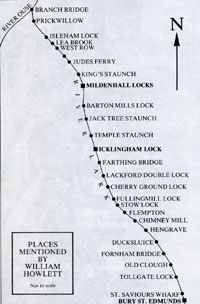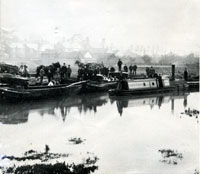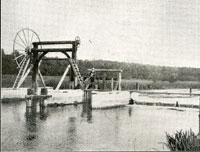 |
 |

INTRODUCTION
RIVERMEN'S JARGON
SOURCES |
and its changing importance
It is hard to imagine that the River Lark, as we see it today, was once capable of being a vital artery of trade for the town of Bury St Edmunds. These days the river is treated as a drain to carry away surface water, and its function is to reduce the risk of flooding in the town. Since the flooding of Bury in 1968, the river through the town has been converted into a concrete channel in many places, the aim being to shift water downstream as quickly as possible.
The River Lark flows into the River Great Ouse at Branch Bridge, near Prickwillow. The Ouse flows through the fens into the Wash at Kings Lynn. It is this route which was for decades the main trade route for heavy goods between Bury St Edmunds and the sea. Goods from London, from the north-east and from all around the North Sea could reach Bury easily via Kings Lynn. It was only the arrival of the railway at Bury in 1846 that led to a drastic decline in river traffic. Nevertheless there was a dramatic revival of the Lark Navigation to Bury in 1892, but the company was bankrupted by 1905, for want of traffic.
The River Lark has a much longer, and more varied, history than we might imagine. For example, there is good evidence that the Romans canalised a stretch of the Lark from Isleham to the Ouse, and there is documentary evidence of attempts at canalisation during the 1600s. The historian soon comes to realise that it is difficult to understand the River Lark in the area of St Edmundsbury, without investigating the river's role in the Fens. The story of the Fens has deeply influenced the story of the River Lark, and so events in the fens have been included, where relevant, in these Chronicles of the River Lark.
Much of the information contained here has been gleaned from the work of David E Weston. In 1980 and 1981 he published two 20 page booklets on the history of the canalisation of the River Lark. In addition he had deposited a much larger, unpublished manuscript in the West Suffolk Record Office, packed with detailed accounts of all the information he had dug up about the Navigation. This manuscript can be examined by visitors to the Record Office in Raingate Street.
The Chronicle of the River Lark is here divided into the years before 1600, and the years after 1600. This is for convenience in some ways, but it is after 1600 when documentary evidence of the attempts to improve the river arise.
The development of the Navigation is perhaps better considered in the following phases: |
 |
A Glossary of Some Canal Jargon GANG The word "gang" was used when three or four, or more barges or boats were tied together one behind the other, in such a manner that, although they were drawn by a single gang horse walking along the bank, they could be steered along the channel of the river. Very often a gang would consist of four lighters, a horse boat capable of carrying about four tons, and a dinghy or cox boat. LIGHTER Lighters were wooden barges without any power of their own. They could carry anything from eight to thirty tons, depending upon their size. In each gang at least one lighter would include a cabin, and often this was placed in the second position of the gang. This cabin might be either in the stem or the centre of the lighter. Stem cabins were a bit smaller, lit by a skylight, but allowed more space for cargo. Centre cabins would be eight or nine feet square, with a window on each side. Cabins held a cooking stove, and all necessities for weeks of life aboard. GANG HORSE The gang horse was the motive power for a gang of barges. These would weigh in excess of thirty tons, and were pulled at about two miles an hour. All the weight was carried on one shoulder, and the horse had to accept a different stable every night. The horse had to learn the tricks of getting on and off the horse boat when needed, and be able to jump stock fences where these were built across the towpath. On meeting a fence the horse had to stop for a minute to allow some slack in the tow lines before he could make his jump. THE BURY WALK This was a term used along the River Lark to describe the habit adopted by some gang horses of pulling for two or three steps, steadying up for a couple of seconds until the rope became slack, then forward another step or two. Elijah Wells thought that this was because it was most noticeable going up from Mildenhall to Bury St Edmunds, where the river was full of turns, and the current was usually rather strong. HORSE BOAT A horse boat was needed whenever the towpath crossed from one side of the river to the other. If there was no bridge, the horse boat would ferry the tow-horse across the river. HORSE DRIVER The gang-horse was led by a horse driver. He might be sixty or seventy yards ahead of the lighter holding the master of the gang. The horse had to be kept strictly on the towing path, and the horse driver had to keep the tow lines clear of stakes or bushes. Any fouling of the line caused the gang of barges to be pulled into the bank. Upon reaching a sluice he would unhook the horse, rest and feed it, and would close the far gate. He also had to get the horse to enter the horse boat if it was needed to cross the river, and had to help it jump any fences that run across the towpath. The horse driver was often a strong lad of about 15 or 16 years of age. In some cases they had no homes, and were taken from the workhouse. COX BOAT The small dinghy or cox boat was used where the river was wide and the edges were too shallow for the lighters to get near enough to the bank. They were propelled by one man in the stern of the boat using a scull. SLUICE In exact modern terms, a sluice is a gate placed in the river to control the flow by raising or lowering it. However, the usage of the term was somewhat different on the River Lark in times past. Elijah Wells never used the term 'lock', and to him, a lock was called a sluice. He lived all his life on the River Lark between Mildenhall and Prickwillow. His father was sluice keeper at Isleham from 1913 to 1924.
He described the actions needed to take a gang of lighters through Isleham Sluice. LOCK OR POUND LOCK A lock is a modern term for what Elijah Wells called a sluice. It consists of two pairs of lock gates which enclose a length of water known as the pound. The pound, or pen, is usually built of brick, and is often made just wide enough to hold one lighter or barge. It may be long enough to hold two or more lighters or barges in a line. Small ancillary sluice gates allow water to enter from upstream to fill the pound, and to drain downstream to empty it. The operation of the lock is just as described by Elijah Wells under the heading of 'sluice', above. POUND A pound is a length of river whose depth is controlled as one entity. Usually it is of a fairly short length, contained with a pair of lock gates. However, in days before locks were commonplace, a pound could stretch for a kilometre or more. Such a pound was controlled by a staunch downstream, usually stretching back upriver to another staunch. Obviously, it took a much bigger supply of water to raise the level of the river over such long distances.
|
 |
STAUNCH OR STANCHE OR FLASH-LOCK A staunch, or flash-lock, is a method of controlling river levels to allow the river to be made navigable. A staunch was built downstream of a shallow stretch, and once a vessel had passed though its gate travelling upstream, the gate was lowered to impede the flow, and thus to deepen the upstream stretch. This could cause a long delay, particularly if the water level had to be raised over several kilometres. One or two of these survived on the River Lark in use right through to the final set of navigation improvements from 1890 to 1905. They were the only method in use in the 17th century, but in the 19th century, Victorian engineers preferred to replace them by locks, which were quicker in operation and more economical in their use of water. However, staunches survived because they were much cheaper and easier to build. Basically a staunch was a single set of gates set into the river, which could be raised and lowered by means of a capstan arrangement. Sometimes a staunch was built which covered only a part of the width of a river, and a staunch island was installed to allow this arrangement. The picture shown here comes, not from the Lark, but is the third staunch downstream from Thetford, called Turfpool staunch, on the Little Ouse, seen before 1925. In his book, "In Breckland Wilds", W G Clarke wrote on staunches, that: "Of these, there are but 32 in England, of which 26 are in the fenland area, and 7 of these are on the Little Ouse....These staunches have an oaken door to hold up the water. This is raised by chains working on an axle, at one end of which is a large wheel on which the operater treads the spokes, and so by turning the wheel, winds up the chain and raises the door, which is held fast by a hook in the spokes of the wheel. Next to the staunch door are one or two sluices, or "cloughs", as they are locally termed, which help to regulate the height of the water, and beyond these is an overfall. In the river below each staunch is a deep pool or "staunch hole", usually a favourite place for fishing and bathing." CHALDRON A chaldron was the unit that was used to measure an amount of coal. Chambers Cyclopedia of 1728 had an entry which defined a chaldron of coal as 36 bushels heaped up. Chambers also declared that a chaldron should weigh 2,000 pounds. We may suppose that a bushel basket was a convenient measure of loose coal that could be handled for long periods by one man in the days before coal was routinely delivered in sacks. A bushel was a unit of volume, not of weight, so it must have only approximately made up the weight quoted by the cyclopedia. Nevertheless, using the Chambers figures would produce a bushel that weighed 55.56 pounds. The chaldron was apparently a recognised unit of measuring coal until it was abolished in 1963. You may wonder how many chaldrons there were in a ton? By the late 20th century a "standard" British ton weighed 2,240 pounds (or lbs), and this was also called the long ton. At one time it was also possible to have a short ton which weighed 2,000 pounds. So a chaldron weighed the same as a short ton, but only 89.3% of a long ton, if all these measures are accurate. In practice, one large lump of coal extra in the basket could easily make the bushel up to 56 pounds in weight. This was a measure well known up to the late 20th century called half a hundredweight, and a hundredweight weighed 112 lbs. Thus twenty hundredweights made up the long, or British standard, ton weighing 2,240 lbs. Just in case you still care, a metric ton weighs 1,000 kilograms, equal to 2,200 lbs. The USA tonne weighs 2,000 lbs, the same as a short ton.
|
|
|
| Go to River Lark Homepage |
This page created January 2008 Last updated 31st January 2008 | Go to Main Home Page |